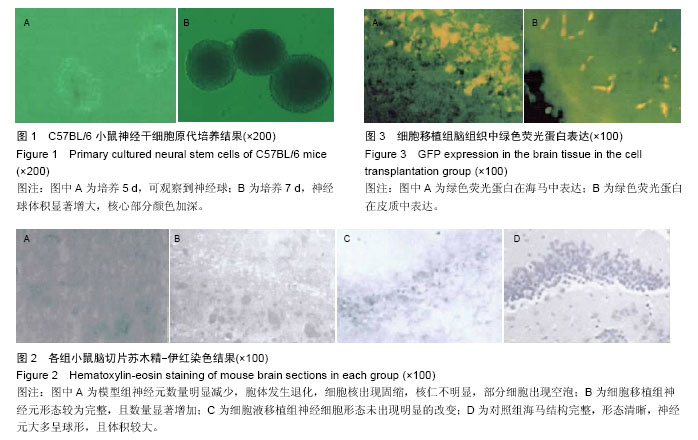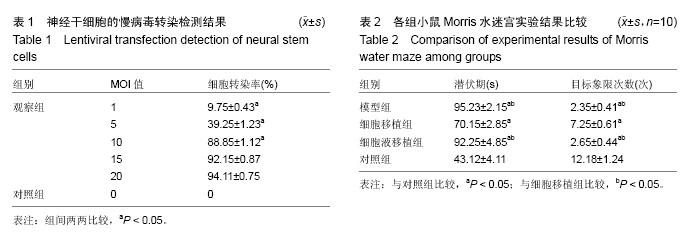| [1] 张喻,肇玉明,王晓良,等.干细胞治疗阿尔茨海默病的研究进展及挑战[J].中国药理学通报,2015,31(7):889- 894.
[2] 詹焱,马涤辉,张昱,等.胎鼠神经干细胞移植对阿尔茨海默病大鼠海马区的GFAP与S-100β表达的影响[J].中华老年心脑血管病杂志,2007,9(2):128-131.
[3] 杨春,周辉,白琳琳,等.神经干细胞移植对阿尔茨海默病大鼠海马突触素表达和学习记忆能力的影响[J].中国组织工程研究与临床康复,2010,14(10):1803-1807.
[4] 杨华山,王金国,蒋莉莉,等.IGF-1修饰的神经干细胞对阿尔茨海默病大鼠学习记忆能力的影响[J].中国老年学杂志,2012,32(20):4465-4467.
[5] Kiyota T, Ingraham KL, Jacobsen MT, et al. FGF2 gene transfer restores hippocampal functions in mouse models of Alzheimer's disease and has therapeutic implications for neurocognitive disorders. Proc Natl Acad Sci U S A. 2011;108(49):E1339-1348.
[6] López-Iglesias B, Pérez C, Morales-García JA, et al. New melatonin-N,N-dibenzyl(N-methyl)amine hybrids: potent neurogenic agents with antioxidant, cholinergic, and neuroprotective properties as innovative drugs for Alzheimer's disease. J Med Chem. 2014;57(9):3773- 3785.
[7] 张炜,王培军,顾国军,等.神经干细胞移植对阿尔茨海默病小鼠Aβ斑块的影响[J].中华医学杂志,2013,93(45): 3636-3639.
[8] 潘学兵,龙大宏,罗秀梅,等.神经干细胞移植对192-IgG-saporin阿尔茨海默病模型鼠基底前脑神经元p75NGFR阳性神经元和行为学的影响[J].中国组织工程研究与临床康复,2010,14(45):8426-8430.
[9] Xuan AG, Luo M, Ji WD, et al. Effects of engrafted neural stem cells in Alzheimer's disease rats. Neurosci Lett. 2009;450(2):167-171.
[10] Vazin T, Ball KA, Lu H, et al. Efficient derivation of cortical glutamatergic neurons from human pluripotent stem cells: a model system to study neurotoxicity in Alzheimer's disease. Neurobiol Dis. 2014;62:62-72.
[11] 湛彦强,王芙蓉,黎逢光,等.神经干细胞经尾静脉移植后在阿尔茨海默病鼠脑组织中的分布[J].中华医学杂志,2007, 87(25):1786-1788.
[12] 盛宝英,李洋,姜尧佳,等.嗅鞘细胞和神经干细胞联合移植阿尔茨海默病大鼠脑内的增殖和定向分化[J].中国组织工程研究与临床康复,2011,15(49):9186-9189.
[13] 姚柏春,孙天敏,冯娜,等.嗅成鞘细胞与神经干细胞共移植对阿尔茨海默病大鼠的治疗作用[J].中国老年学杂志,2012,32(11):2314-2316.
[14] Chang KA, Kim JA, Kim S, et al. Therapeutic potentials of neural stem cells treated with fluoxetine in Alzheimer's disease. Neurochem Int. 2012;61(6): 885-891.
[15] Waldau B, Shetty AK. Behavior of neural stem cells in the Alzheimer brain. Cell Mol Life Sci. 2008;65(15): 2372-2384.
[16] 陈双庆,蔡庆,沈玉英,等.神经干细胞移植治疗APP/PS1小鼠磁共振波谱及行为学对照研究[J].中华行为医学与脑科学杂志,2013,22(11):965-968.
[17] Eder-Colli L, Abad-Estarlich N, Pannetier C, et al. The presenilin-1 familial Alzheimer's disease mutation P117L decreases neuronal differentiation of embryonic murine neural progenitor cells. Brain Res Bull. 2009; 80(4-5):296-301.
[18] Marutle A, Ohmitsu M, Nilbratt M, et al. Modulation of human neural stem cell differentiation in Alzheimer (APP23) transgenic mice by phenserine. Proc Natl Acad Sci U S A. 2007;104(30):12506-12511.
[19] Xuan AG, Long DH, Gu HG, et al. BDNF improves the effects of neural stem cells on the rat model of Alzheimer's disease with unilateral lesion of fimbria-fornix. Neurosci Lett. 2008;440(3):331-335.
[20] 武强,李露斯,范文辉,等.小鼠胚胎神经干细胞海马移植对APP/PS1双转基因AD小鼠的治疗作用[J].第三军医大学学报,2007,29(10):915-918.
[21] Becker M, Lavie V, Solomon B. Stimulation of endogenous neurogenesis by anti-EFRH immunization in a transgenic mouse model of Alzheimer's disease. Proc Natl Acad Sci U S A. 2007;104(5):1691-1696.
[22] 詹焱,张昱,马涤辉,等.胎鼠海马神经干细胞移植对阿尔茨海默病大鼠行为学及海马线粒体膜电位的影响[J].中风与神经疾病杂志,2006,23(1):30-33,插1.
[23] Chen SQ, Cai Q, Shen YY, et al. Neural stem cell transplantation improves spatial learning and memory via neuronal regeneration in amyloid-β precursor protein/presenilin 1/tau triple transgenic mice. Am J Alzheimers Dis Other Demen. 2014;29(2):142-149.
[24] Hong BH, Ha S, Joo Y, et al. Amyloid precursor protein binding protein-1 knockdown reduces neuronal differentiation in fetal neural stem cells. Neuroreport. 2012;23(2):61-66.
[25] Fonseca MB, Solá S, Xavier JM, et al. Amyloid β peptides promote autophagy-dependent differentiation of mouse neural stem cells: Aβ-mediated neural differentiation. Mol Neurobiol. 2013;48(3):829-840.
[26] Song S, Park JT, Young Na J,et al.Early expressions of hypoxia-inducible factor 1alpha and vascular endothelial growth factor increase the neuronal plasticity of activated endogenous neural stem cells after focal cerebral ischemia. Neural Regen Res. 2014; 9(9): 912-918.
[27] 姚柏春,冯娜,王军,等.嗅成鞘细胞与神经干细胞共移植对阿尔茨海默病大鼠海马生长相关蛋白-43表达的影响[J].山西医药杂志,2012,41(19):976-979.
[28] 于程程,张斌,陈虎,等.干细胞移植治疗阿尔茨海默病的研究现状及展望[J].中国组织工程研究,2012,16(23): 4301-4305.
[29] 姚柏春,冯娜,王军,等.嗅成鞘细胞与神经干细胞共移植对阿尔茨海默病大鼠海马生长相关蛋白-43表达的影响[J].山西医药杂志,2012,41(10):976-979.
[30] Feng ZL, Zhao G, Yu L. Neural stem cells and Alzheimer's disease: challenges and hope. Am J Alzheimers Dis Other Demen. 2009;24(1):52-57.
[31] Lee HJ, Lim IJ, Park SW, et al. Human neural stem cells genetically modified to express human nerve growth factor (NGF) gene restore cognition in the mouse with ibotenic acid-induced cognitive dysfunction. Cell Transplant. 2012;21(11):2487-2496.
[32] Chen SQ, Cai Q, Shen YY,et al. 1H-MRS evaluation of therapeutic effect of neural stem cell transplantation on Alzheimer's disease in AβPP/PS1 double transgenic mice.J Alzheimers Dis. 2012;28(1):71-80.
[33] Khandekar N, Lie KH, Sachdev PS, et al. Amyloid precursor proteins, neural differentiation of pluripotent stem cells and its relevance to Alzheimer's disease.Stem Cells Dev. 2012;21(7):997-1006.
[34] 陈双庆,蔡庆,沈玉英,等.神经干细胞移植治疗APP-PS1转基因阿尔茨海默病小鼠的1H-MR波谱研究[J].中华放射学杂志,2012,46(2):164-169. |
.jpg)


.jpg)
.jpg)